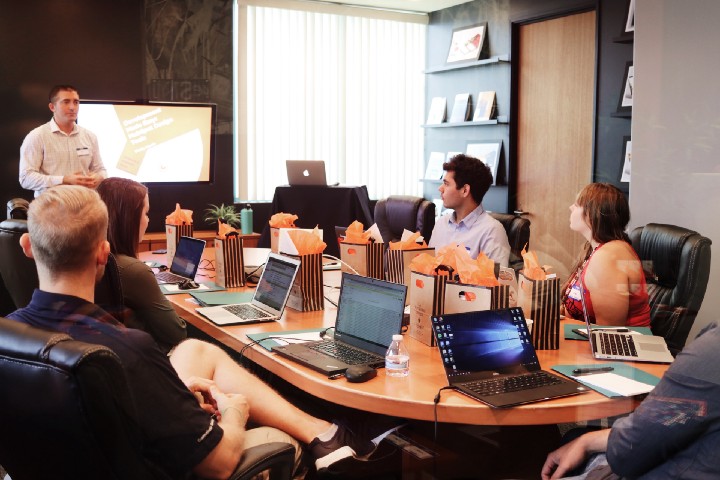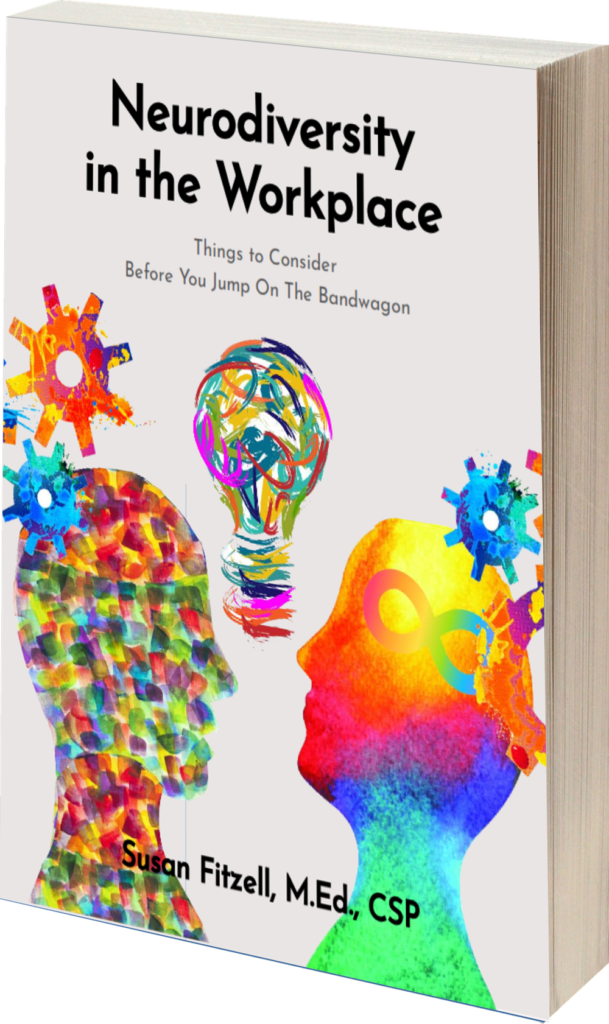
How to accommodate neurodivergent employees with learning disabilities in the workplace
Neurodiversity in the workplace is a hot topic. Employers are beginning to realize that a diverse staff is good for business. Yet, for employees with learning differences to thrive, they must be set up for success. This means changing the way organizations think and do business by implementing Dynamic Workplace Design™
The good news is, accommodating employees with learning differences doesn’t have to be complicated or expensive. Research shows that up to 59% of workplace adjustments cost nothing to the employer (CIPD, 2018). Here are some ways that Human Resources (HR) can accommodate adults with learning differences to maximize their organizational potential.
1 – Train your staff
You can’t do better until you know better. Implementing mandatory neurodiversity education and awareness training for all employees to help reduce cognitive bias is a great start. Negative external perceptions and stereotypes of neurodiversity are common (Burton, Carss, Twumasi, 2022.) Helping staff improve their understanding, respond to colleagues with empathy, and implement more inclusive practices can dramatically improve workplace culture (CIPD, 2018).
Expand neurodiversity training to management. Offering coaching to “expand awareness around reasonable adjustments to support staff who may be in the neurominority” helps create a supportive workplace culture from the top down (Gaul, 2021).
2 — Improve the onboarding experience of new employees
Often new employees are given a short orientation and an extensive employee handbook. They are expected to figure out the rest on their own, but the unwritten workplace rules are often complicated. Employers can help smooth that transition with a few simple changes to the onboarding process. Provide information about job expectations in advance and make it available in different formats. Highlight ‘obvious’ aspects such as expected working hours, typical break times, dress code, social events, and communication channels (CIPD, 2018).
3 – Ask for input
Simple questionnaires during the onboarding process that ask about workplace preferences can be invaluable. Include preferred location and workspace design, accommodation requests, and technology requirements. Tech requirements might include speech-to-text and text-to-speech as well as video speed controllers that adjust the rate of speed for content being listened to. Repeat the survey on an annual basis for all employees.
Often employees are reticent to disclose learning differences to employers. Questionnaires about workplace preferences and accommodations allow employees to ask for their preferences without requiring disclosure. Providing these questionnaires to all employees allows for a better work experience for all (Volpone, Avery, Wayne, 2022).
4 – Focus on strengths
Typical workplace feedback focuses on areas of weakness: the deficit model. Employee personal development plans often skew heavily toward working on areas in which the employee struggles the most. However, research suggests that this is not the most effective way to get the best out of employees. The opposite seems to be more effective. A strengths-based approach to task and employee management is correlated with better productivity. Research has shown that strengthening skill areas is more effective than working on skill deficits (CIPD, 2018).
5 – Dynamic Workspace Design™
Designing inclusive workspaces helps level the playing field for adults with learning differences. Considering the sensory environment is critical. Allowing for flexible workspace arrangements, such as providing quiet spaces, comfortable lighting, and low-traffic areas, are reasonable and easy to implement in many workplace environments (Wille, Sajous-Brady, 2018).
6 – Accommodations
In an ideal workplace, necessary accommodations would be available to all employees. Text-to-speech functionality, voice supports, screen customization, and social media tools are just some examples of technological accommodations that support the employee with learning differences, but that can also be helpful to all employees (Gronseth, Hutchins, 2019). Other accommodations can include providing meeting materials in advance, support for emails or other written materials, and avoiding spontaneous presentations or on-the-spot questions.
7 – Clear task communication
Clear communication is critical to getting the best out of all employees. Vague, generic instructions are often confusing for the employee with learning differences. Executive functioning skills around planning, prioritizing, and allocating adequate time to complete tasks are common areas of struggle for neurodivergent employees. Employers can help improve success by clearly communicating task expectations using multiple formats. Process clarifying flow charts, mnemonic devices, checklists, shared calendars, and ongoing milestones are encouraged.
8 – Mentoring
Ongoing mentoring for neurodivergent employees is a positive way to provide continuous informal feedback and on-the-job training. Mentors are also available to address concerns as they arise rather than wait till there’s a bigger problem. Mentoring programs, with mentors trained to support neurodivergent employees, provide that ongoing informal support that can help those with learning differences close some of the gaps that would otherwise be difficult to overcome.
9 — Reverse mentoring
Reverse mentoring programs have recently become popular to bridge the gap between senior and junior staff members in organizations. They can also harness the often-overlooked talents of neurodivergent employees (Kaše, Saksida, Mihelič, (2019). These employees often bring heightened creative thinking, identification of complex patterns, And advanced technological skills. By leveraging employees’ strengths with learning differences, organizations can help close the skills gap, foster crucial networking relationships, and improve retention and employee loyalty.
10 – Support circles
Support circles are designed with a broader scope in mind than one on one mentoring. They help new employees meet others within the organization and provide support during the crucial adjustment phase. For more experienced employees, support circles provide information, feedback, and a sounding board for navigating new challenges in the workplace. They can also be agents for change within a workplace setting.
11 – Professional development opportunities
Often managers overlook neurodivergent employees for professional development training opportunities, or the training is delivered in a way that is not optimal. “A full 67% of workplace learning programs are instructor-led, and 53% of those are in face-to-face formats, including virtual learning” (Gronseth, Hutchins, 2020). Using Universal Design for Learning practices in developing professional development training programs embraces learner differences and accounts for diversity during the planning stages. Even when professional development is offered using traditional methods, neurodivergent employees can benefit from a few modifications, such as 1) providing materials in advance, 2) in multiple formats, and 3) being flexible in how employees show their understanding of training materials.
12 – Invest in retention and advancement
Hiring employees with learning differences is just the start. Challenging them to learn and grow and providing opportunities for advancement and retention is a worthwhile investment. According to research by Burton, Carss, and Twumasi (2022), limitations placed by managers are considered one of the top two limiting factors in career progression for neurodivergent employees. One way to improve the retention of neurodivergent employees is by Fostering dynamic workplace design and committing to an organization-wide culture of inclusion and equity.
References
Burton, L., Carss, V., & Twumasi, R. (2022). =v. Ought: The Journal of Autistic Culture, 3(2), 56–79.
CIPD. (2018). Neurodiversity at work. Retrieved from www.cipd.co.uk/Images/neurodiversity- at-work_2018_tcm18–37852.pdf
Gaul, P., (2021). Neurodiversity benefits employers, TD Magazine. Retrieved from Neurodiversity Benefits Employers | ATD
Gronseth, S. L., & Hutchins, H. M. (2020). Flexibility in formal workplace learning: Technology applications for engagement through the lens of Universal Design for Learning. TechTrends, 64(2), 211–218.
Kaše, R., Saksida, T., & Mihelič, K. K. (2019). Skill development in reverse mentoring: Motivational processes of mentors and learners. Human Resource Management, 58(1), 57–69.
Volpone, S., Avery, D. R., & Wayne, J. (2022). Shaping Organizational Climates to Develop and Leverage Workforce Neurodiversity. In Neurodiversity in the Workplace. Taylor & Francis.
Wille, S., & Sajous-Brady, D. (2018). The inclusive and accessible workplace. Communications of the ACM, 61(2), 24–26.
Neurodiversity Definition
Neurodiversity: this term refers to a general diversity of minds. It includes people who are neurotypical and neurodivergent. When I talk about promoting neurodiversity in the workplace, for example, I am referring to creating a diverse workforce representative of the broad spectrum that exists when it comes to ways of thinking, processing information, communication, and learning. Some employees may be “normal” or neurotypical while others may have ADHD, Dyslexia, Autism, or trauma impacted ways of thinking. I am not referring to any particular label or diagnosis, but rather, the concept of an environment where a diversity of minds coexist.
Neurodiverse: This word is pretty much the same as neurodiversity, but should be used as an adjective. You can say, for example, that your workplace is neurodiverse.
Be careful though, because you should never describe a person as being neurodiverse. Individual people should be described as neurodivergent.
Neurodivergent: This word describes an individual whose way of thinking falls outside of society’s defined version of normal. Oftentimes you will see it abbreviated as ND.
Many times, neurodivergent people will have a diagnosis or label you may recognize, like autism, dyslexia, or ADHD. But neurodivergent people are also those with epilepsy, different kinds of brain trauma, or simply a unique way of thinking that may not have a specific diagnosis.
Photo Credit: Campaign Creators on Unsplash
CLICK HERE to visit the articles page.
 FREE DOWNLOAD: Neurodiversity in the Workplace: Things to Consider Before You Jump On the Bandwagon
FREE DOWNLOAD: Neurodiversity in the Workplace: Things to Consider Before You Jump On the Bandwagon
Neurodiverse hiring practices can benefit any company in any industry and in more areas than most people realize. The investment has yielded greater patenting, innovation, process improvement, efficiency, and creativity not only in technology industries but also in industries that include investment banking, insurance, and mortgage banking.
This resource explains the term “neurodiversity” and describes the potential positive impact on your business that can come from including neurodivergent individuals in your workplace.
Download Neurodiversity in the Workplace! – Free!
Bring Susan Fitzell, M.Ed., CSP
Top Neurodiversity Speaker
To YOUR Organization!

